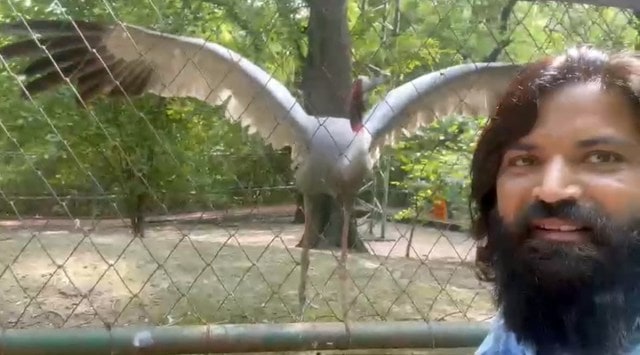Mohammad Arif decided to pay a visit to Kanpur Zoo last Wednesday to meet the Sarus he had nurtured for nearly a year after he chanced upon an Instagram reel and quickly recognised the bird. But the visit had to be kept “secret”, fearing that zoo officials could recognise him and might not let him meet the bird.
“I saw the video shot inside the common cage of Kanpur Zoo and recognised that the Sarus in it was the one which had stayed with me. I recognised it because of the injury on one of its legs. That was the reason I had brought the bird home. Because it had a broken leg. So, when I saw the same bird on social media, I made up my mind that I will visit the zoo,” said 35-year-old Mohammed Arif, a farmer from Amethi’s Mandhka village.

The next day, he drove 200 km from his village to reach Kanpur and entered the zoo wearing a surgical mask.
Story continues below this ad
On reaching the enclosure where the Sarus was kept along with other birds, he first made some sound to draw its attention. And once the Sarus came close, he said hello and took off his mask. Like their last rendezvous on April 10, which happened under the watch of the officials, the Sarus this time too put on a show: it jumped up and down, flapped its wing and started doing a sort of dance, moving its long elegant neck up and down. “Pehchan gaye (Recognised me),” said Arif, and the bird almost seemed to nod in agreement.
 Mohammad Arif with the sarus crane.
Mohammad Arif with the sarus crane.
Arif, who spent 10 minutes with the bird, shared the 90-second video of his meeting the Sarus on social media last Friday.
The Sarus had hit headlines earlier this year, thanks to its friendship with Arif, who says he found the bird in the wild, wounded and with a broken limb, in February 2022. Arif applied “turmeric and mustard oil paste on the bird’s wound” and tied a stick on its limb for support. After the bird recovered, videos of Arif riding his bike as the Sarus flew alongside started going viral on social media. However, in March the authorities seized the Sarus, citing “legal reasons” since the state bird of Uttar Pradesh is protected and cannot be domesticated under the Wildlife Protection Act.
After leading a quiet existence in a 40 x 25-foot secret enclosure at the zoo since March 25, following separation from “friend” Arif, the Sarus was recently moved to a common enclosure with other birds and ducks. Officials said that this was done after the bird showed signs of “improvement”.
Story continues below this ad
“It has shown less effects of human imprinting and hence, it was shifted a month ago to a common enclosure with other birds. Now, the bird is eating natural food and is not eating Maggi (noodles) and dal-chawal which it used to eat earlier. It is now eating natural food like worms etc,” said a senior official at the zoo. “The bird can’t stay in the wild, and needs to be kept in a controlled environment because it has lost its survival instincts,” added the official.
Officials, however, refused to divulge the current location of the bird, citing “its safety”.
“Pinjre mein rakhna bilkul theek nahi hai (It is not right to keep it in the cage),” Arif told The Indian Express after meeting the Sarus again. “I just want that the bird should be sent to a sanctuary where it can move around freely. Keeping such a big bird that is used to being free seems very cruel to me,” he said.
“I will go again to see it in a couple of days if the authorities allow me,” he added.
Kanpur Zoo Director Krishna Kumar Singh, meanwhile, said there was no issue with Arif visiting the zoo. “Anyone can come to the zoo, and see the animals. There is no issue with it,” said Singh.
Story continues below this ad
When asked about the current location of the Sarus, Singh said, “I can’t give you the exact location for its safety. Animals are continually rotated… I haven’t seen the video (of Arif with the bird) and I can’t comment on whether the bird in the video is the same Sarus that Arif had kept.”
Another official at the zoo, who wished to remain anonymous, said that “Arif ka Sarus (Arif’s Sarus)”was recently shifted to a common cage with other birds. “I can’t tell the exact date but it happened some time back,” said the official.
Speaking to The Indian Express, KS Gopi Sundar, editor-in-chief of Waterbirds Society, and co-chair of the IUCN Stork, Ibis and Spoonbill Specialist Group, who has worked on Sarus cranes since 1998, said that he doesn’t think that the bird would ever forget Arif. “Birds are broadly divided into two categories — altricial or precocial. The Sarus is a precocial bird which starts moving just hours after the egg hatching. This behaviour of precocial birds is that they form a bond with whatever creature they are close to… From the perspective of conservation, this isn’t a good practice – when they bond with humans. We prefer they bond with each other, rather than with humans,” said Sundar, adding that the Sarus was “reinforcing the bond it has with Arif – a positive reinforcement behaviour – in the video”.
“The circumstances of Arif keeping the bird is a rare one, and needs a special approach where everyone takes a step back to keep the bird away from the gaze of the people,” Sundar said, adding that the bond between Arif and the Sarus is in all likelihood seemed to be a “romantic one”. “The bond between Arif and the Sarus is not a parental one, but one that is seen between partners in cranes. Sarus cranes don’t have bonds with their parents, so this is definitely one that it has with its partners,” said Sundar.


 Mohammad Arif with the sarus crane.
Mohammad Arif with the sarus crane.






